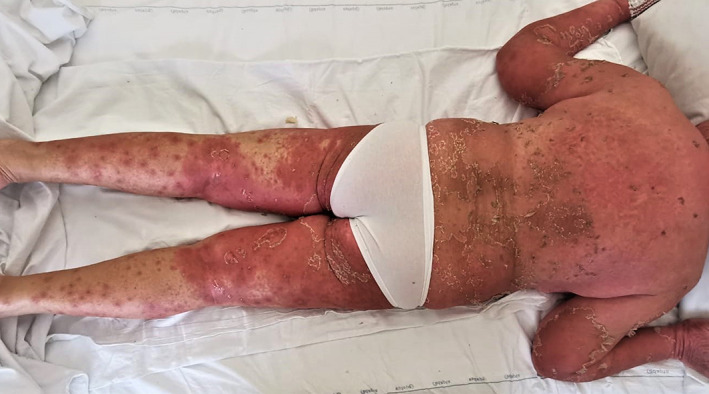Dear Editor,
Drug reaction with eosinophilia and systemic symptoms (DRESS) syndrome is a rare and severe cutaneous adverse reaction that requires early withdrawal of the causative agent and is characterized by skin rash, fever, hematological abnormalities, and lymphadenopathy with involvement of several internal organs. 1 , 2 The most frequently involved drugs are anticonvulsants, sulfonamides, allopurinol, and antibiotics, while hydroxychloroquine was rarely reported as causative agent. 3 The etiologic diagnosis is often difficult and specific clinical, biological and histological findings are needed. Moreover, a hybrid entity with overlapping clinical and histopathological features of DRESS syndrome, acute generalized exanthematous pustulosis, Stevens‐Johnson syndrome, toxic epidermal necrolysis, and Sweet's syndrome secondary to hydroxychloroquine has been described in the literature. 4
A 69‐year‐old woman was hospitalized for severe maculopapular itchy eruption, with erythema multiforme‐like aspect. The skin lesions appeared on trunk associated with a severe facial edema and then rapidly spread to the whole‐body surface with massive exfoliation (Figure 1). The overall skin rash extent was more than 50% body surface area. The temperature was 38.7°C and multiple lymphadenopathies were present. Laboratory tests showed severe leukocytosis (WBC 28180/μL) with absolute eosinophilia (9%, n.v. 0.5%‐7.2%), abnormal renal function (blood urea nitrogen 67 mg/mL, n.v. >90 mg/mL; serum creatinine 2.88 mg/dL, n.v. 0.51‐0.95 mg/dL), and C‐reactive protein (36.9 mg/L, n.v. <2.9 mg/L). Polymerase chain reaction for human herpesvirus (HHV) 7 was positive in both serum and whole blood. Other serological investigations (antinuclear antibodies, serology for HAV/HBV/HCV and EBV, antibodies to chlamydia/mycoplasma) resulted negative. Full‐body CT scan showed bilateral inguinal lymph nodes enlargement. Histopathological examination revealed interface dermatitis with apoptotic keratinocytes.
FIGURE 1.

Generalized maculopapular eruption associated to erythema multiforme‐like aspect on the lower limbs with massive exfoliation in a 69‐year‐old woman
History revealed that the skin lesions appeared 20 days after starting a therapy with hydroxychloroquine (400 mg/d) for lichen planopilaris of the trunk. Her medical history included hiatal hernia treated since 2017 with proton pump inhibitors, arterial hypertension treated since 2010 with angiotensin‐converting enzyme inhibitors, and Hashimoto's thyroiditis treated since 2005 with levothyroxine.
Withdrawal of hydroxychloroquine and therapy with methylprednisolone (60 mg/d) resolved skin lesions and laboratory abnormalities in 1 and 2 months, respectively.
Based on the RegiSCAR scoring system, 5 “definite” DRESS syndrome (final score 7: fever (0), enlarged lymph nodes (1), eosinophilia (2), skin rash suggesting DRESS (1), extent >50% of BSA (1), biopsy suggesting DRESS (0), one organ involved (1), resolution in >15 days (0), evaluation of other potential causes (1)) was diagnosed.
DRESS syndrome is a severe adverse drug reaction occurring 3 to 8 weeks after the first administration of several medications, with fatal outcome in 10% of cases. The disease is a delayed T‐cell mediated reaction classified as type IVb hypersensitivity (T helper type 2 cells, eosinophils) with a complex pathogenesis including drug allergy and viral reactivation (HHV‐6, HHV‐7, EBV, CMV, and HCV). 5 Hydroxychloroquine is a synthetic antimalarial drug, long‐time used in dermatology and rheumatology for its immunosuppressive properties. It interferes with lysosomal activity and membrane stability and can alter signaling pathways and transcriptional activity, inhibiting cytokine production and modulation of certain co‐stimulatory molecules. 6 Despite some adverse effects, it remains an important and safe drug. Recently, hydroxychloroquine stepped into the spotlight because of its antiviral activity against SARS‐CoV‐2, causative agent for coronavirus disease 2019 (COVID‐19), in particular when associated to azithromycin. 7 , 8 Despite the concern that some immunosuppressants may increase the risk of COVID‐19 infection or complications in infected patients, 9 there is some hope that hydroxychloroquine can be effective in treating or preventing this pandemic. 7 , 8 Therefore, the use of hydroxychloroquine is dramatically increasing and physicians should be aware of possible severe adverse reactions, such as DRESS syndrome, caused by this “old” drug with a “new” therapeutic role for COVID‐19.
CONFLICT OF INTEREST
The authors declare no potential conflict of interest.
REFERENCES
- 1. Foti C, Antelmi A, Mazzocca A, et al. Drug reaction with eosinophilia and systemic symptoms caused by lenalidomide. Eur J Dermatol. 2012;22:799‐800. [DOI] [PubMed] [Google Scholar]
- 2. Hansel K, Bellini V, Bianchi L, Brozzi J, Stingeni L. Drug reaction with eosinophilia and systemic symptoms from ceftriaxone confirmed by positive patch test: an immunohistochemical study. J Allergy Clin Immunol Pract. 2017;5:808‐810. [DOI] [PubMed] [Google Scholar]
- 3. Girijala RL, Siddiqi I, Kwak Y, Wright D, Patel DB, Goldberg LH. Pustular DRESS syndrome secondary to hydroxychloroquine with EBV reactivation. J Drugs Dermatol. 2019;18:207‐209. [PubMed] [Google Scholar]
- 4. Schwartz RA, Janniger CK. Generalized pustular figurate erythema: a newly delineated severe cutaneous drug reaction linked with hydroxychloroquine. Dermatol Ther. 2020;6:e13380. 10.1111/dth.13380. [Epub ahead of print]. [DOI] [PMC free article] [PubMed] [Google Scholar]
- 5. Cho YT, Yang CW, Chu CY. Drug reaction with eosinophilia and systemic symptoms (DRESS): an interplay among drugs, viruses, and immune system. Int J Mol Sci. 2017;18:1243‐1263. [DOI] [PMC free article] [PubMed] [Google Scholar]
- 6. Schrezenmeier E, Dörner T. Mechanisms of action of hydroxychloroquine and chloroquine: implications for rheumatology. Nat Rev Rheumatol. 2020;16:155‐166. [DOI] [PubMed] [Google Scholar]
- 7. Gautret P, Lagier JC, Parola P, et al. Hydroxychloroquine and azithromycin as a treatment of COVID‐19: results of an open‐label non‐randomized clinical trial. Int J Antimicrob Agents. 2020;20:105949. [DOI] [PMC free article] [PubMed] [Google Scholar] [Retracted]
- 8. Conforti C, Giuffrida R, Zalaudek I, Di Meo N. Doxycycline, a widely used antibiotic in dermatology with a possible anti‐inflammatory action against IL‐6 in COVID‐19 outbreak. Dermatol Ther. 2020;33(4):e13437. 10.1111/dth.13437. [DOI] [PMC free article] [PubMed] [Google Scholar]
- 9. Conforti C, Giuffrida R, Dianzani C, Di Meo N, Zalaudek I. COVID‐19 and psoriasis: is it time to limit treatment with immunosuppressants? A call for action. Dermatol Ther. 2020;33(4):e13298. 10.1111/dth.13298. [DOI] [PMC free article] [PubMed] [Google Scholar]


